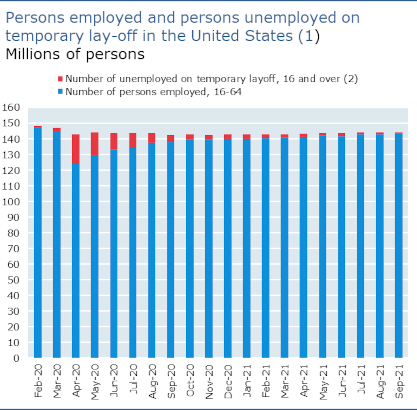21 Oct 2021 – The employment rate, which is the percentage share of the working-age population with jobs, rose to 67.4% (from 66.9% in the previous quarter) in the OECD area in the second quarter of 2021. Increases were reported in more than four-fifths of OECD countries. There was also an increase in the OECD area labour force participation rate – the share of the working-age population that is either employed or unemployed – to 72.2%, up from 71.8% in the first quarter of 2021 (see Table 4). In the second quarter of 2021, the OECD area employment rate rose at broadly the same pace for women (to 60.1%, from 59.6% in the first quarter of 2021) and men (to 74.7%, from 74.3%), while it increased faster for youth (aged 15 to 24), from 39.9% to 40.8%, than for other age groups.
While this quarter’s rise in employment suggests a continued overall recovery towards pre-pandemic rates (see Table 1), care is needed in interpreting the latest OECD area employment rate. Methodological changes to the EU Labour Force Survey1 blur the comparison between the fourth quarter of 2020 and subsequent quarters for EU countries. In addition, a large part of the increase in the third and, to a lesser extent, fourth quarter of 2020 reflects the return to work of furloughed workers in Canada and the United States, where they are recorded as unemployed, whereas in most other countries, including European member states, they are recorded as employed.
In the euro area, the employment rate increased to 67.6% in the second quarter of 2021, from 67.0% in the first quarter, with increases of 1.0 percentage point or more in about half of the countries, including rises of more than 2.0 percentage points in Greece (to 56.4%) and Slovenia (to 71.7%). Diverging from the majority, there was a noteworthy fall in the employment rate for Estonia (from 74.1%, to 72.9%)
The employment rate increased by 0.4 percentage point in the United Kingdom (to 75.1%), and by more than 1.0 percentage point in Denmark (to 75.4%), Iceland (to 79.3%) and Norway (to 75.9%). By contrast, it declined by 0.6 percentage point in Switzerland (to 78.6%).
In Mexico, the employment rate increased by a further 1.5 percentage points (to 61.1%), while it declined in Costa Rica (to 55.6%, from 56.0%) and Colombia (to 59.6%, from 60.8%), after three quarters of recovery. The rate increased slightly in Japan, to 77.7%, only 0.3 percentage point below the pre-pandemic rate (the fourth quarter of 2019), while the employment rate for Australia (up by 0.9 percentage point) reached 75.3%, exceeding the pre-pandemic rate by 1.0 percentage point. In spite of increases, the employment rate in the United States (up to 68.9%, from 68.4%) and Canada (up to 72.4%, from 72.1%) remained respectively 2.7 and 1.7 percentage points below the pre-pandemic rate. Nevertheless, more recent data for the third quarter of 2021 show that the employment rates increased further in the United States (to 69.7%) and Canada(to 73.8%).
| |
Break in time series for the euro area between Q4 2020 and Q1 2021 resulting from . This break also affects, to some extent, aggregates for the OECD-Total. – Source: Quarterly Labour Market Statistics, OECD | (1) The chart provides a more comparable view of movements in US employment statistics with movements in most other OECD countries, where furloughed workers are included in official employment statistics. It should however not be interpreted as alternative official statistics for the United States. In this chart, the number of employed covers age group from 16 to 64, while the number of unemployed on temporary lay-off covers age group 16 and over. (2) US Current Population Survey data |
1. Changes to the from 2021 onwards result in time series breaks between the 4th quarter of 2020 and the 1st quarter of 2021 for EU countries. More details on the main methodological changes to the EU LFS can be found .









